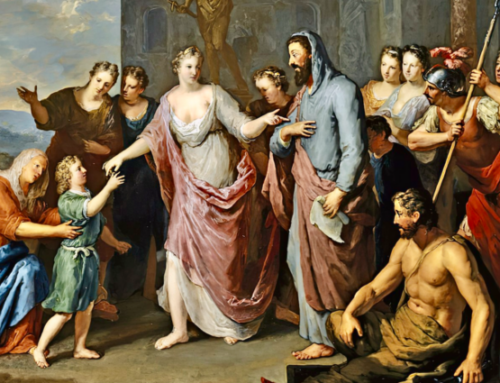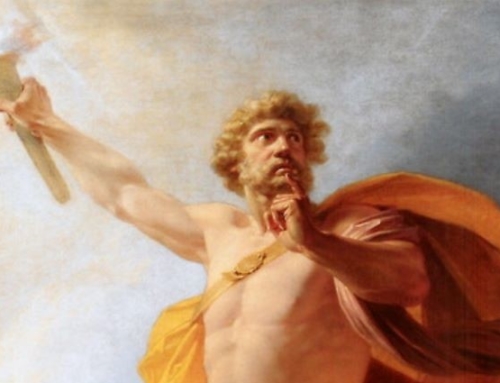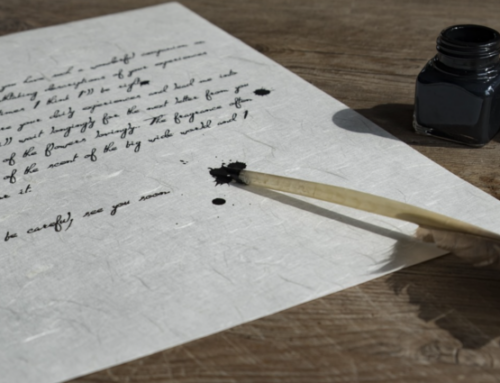The Christian Church’s ongoing struggle with modernity is unavoidable. How does a two-thousand-year-old religion, with roots even further into antiquity, adapt to a world not only technologically astonishing, but philosophically post-Christian, totally materialistic, and indifferent towards God? George Weigel answers this question in “The Irony of Modern Catholic History.”
The Irony of Modern Catholic History: How the Church Rediscovered Itself and Challenged the Modern World to Reform, by George Weigel (336 pages, Basic Books, 2019)
 During one of my many visits to Benedictine monasteries, one of the monks observed, “It’s the Mennonite in you that is drawn to the monastery isn’t it?”
During one of my many visits to Benedictine monasteries, one of the monks observed, “It’s the Mennonite in you that is drawn to the monastery isn’t it?”
He was right. My Swiss Mennonite ancestors found refuge in William Penn’s colony in the 1770’s. The irony of the Mennonites and other Anabaptist groups is that they were primitivists—looking to re-create a simple, New Testament, Spirit-filled communalism, and in their reactionary zeal they were militantly up to date. To put it simply, in the eighteenth century it was up to date to be out of date.
The Protestant Reformers responded to the corruption and complexity of the Catholic Church with various forms of primitivism, while for the Enlightenment thinkers like Voltaire to be up to date was to throw out not just the Catholic fripperies and foolishness overboard, but to jettison the whole Christian faith as an overblown, archaic, superstitious load of nonsense. Ironically, the Jacobins version of primitivism was to replace Christianity with a bizarre form of rationalistic neo-paganism complete with a goddess and Madame Guillotine.
This struggle with modernity is the theme of George Weigel’s latest book, The Irony of Modern Catholic History. The tug of war has been between those who react to modernity by retreating into the fortress of Catholicism’s timeless truths, from which they fire fusillades of anathemas and excommunications from the battlements, or those who seek to reason with the enemy—forging a way forward through theology, diplomacy, dialogue, and détente.
Although he might have started with the sixteenth century, Dr. Weigel charts this drama beginning with the papacies of Gregory XVI (1831-46) and Pius IX (1846-78). Gregory XVI and Pius IX responded to the threat of modernism by hurling denunciations against enlightenment ideas. Behind the scenes, theologians were insisting that the church needed to find ways to accept what was good about the modern world, and Pope Leo XIII (1878-1903) begins a cautious rapprochement through his social teaching. His encyclical Rerum Novarum opens a new way for the Catholic faith to be applied to modern social conditions.
Any hint of adaptation to the modern world was quashed by the staunch anti-modernist Pope Pius X (1903-14), while Benedict XV (1914-22) steered the church through the horrors of the first world war. A diplomat at heart, Benedict XV attempted dialogue with the modern world, tried to repair Vatican relations with European states, and reached out to Protestants.
His successor, Pius XI (1922-39) navigated the tempest of the years between two wars, advancing missionary efforts and moving the church towards a more global perspective. Pius XII (1939-58) moved the church towards modernity with three encyclicals that re-centered the church on Christ, advanced modern Biblical studies and the new liturgical movement. John XXIII (1958-63) was the elderly place holder who surprised the world by calling the church to engage positively with the modern world through the Second Vatican Council, while Paul VI (1968-78) completed his work through controversy and seeming failure. After the short papacy of John Paul I, John Paul II (1978-2005) and Benedict XVI (2005-13) broke the Italian monopoly on the papacy and drove the church forward to an uncertain implementation of the Second Vatican Council.
Dr. Weigel’s book, however, is not simply a history of the modern papacy. He explores the philosophers and theologians who were active during the last two centuries as well as the political, economic, and cultural currents that have shaped the modern world.
The Christian Church’s ongoing struggle with modernity is unavoidable. How does a two-thousand-year-old religion with roots even further into antiquity, adapt to a world not only technologically astonishing, but philosophically post-Christian, totally materialistic, and indifferent towards God? One of the answers continues to be a Mennonite-like retreat into seclusion, primitivism, and antiquarianism. Some wish to withdraw from the modern world to recreate simple communal living with “the Benedict option” Others get out their broadswords and fire their broadsides against every hint of modernity through books, blogs, websites, and militancy. Some take refuge in the recreation of an ideal Baroque liturgy and the certainties of the Council of Trent.
At the other end of the extreme are those who believe the church not only can, but must adapt to the modern age. For them all dogmas and moral teachings are to be understood from a “pastoral” point of view. Everything must be flexible and adaptable to different cultures and circumstances. Ecumenism and inter-faith discussions are rooted in Catholicism’s innate adaptability which they see as her greatest strength.
Dr. Weigel is an optimist and sees the Hegelian struggle of the Catholic Church over the last few centuries as evidence of genuine life and vigor. While he admits the pitfalls and failures, he sees the overall thrust as positive. The losses have been worth it in his view, and despite all predictions to the contrary, the Catholic Church has emerged leaner, meaner, and ready to challenge the modern world as never before.
Not everyone will agree. Those who only see change and decay and blame the Second Vatican Council for all the Catholic Church’s present woes will write off Dr. Weigel as hopelessly naive at best and at worst a sycophantic establishment man. Such criticism says more about them than Dr. Weigel.
Whether you agree with all his conclusions or not, everyone who is concerned with the crisis in the Catholic Church today should take the time to read Dr. Weigel’s book in order to understand the historical background of the present situation. While it may not convince the pessimists or traditionalists, it will help many to understand the roots of the present crisis, and perhaps predict the church’s trajectory through the rest of this century.
I would therefore recommend readers to look again at John Allen’s 2009 book The Future Church. Now ten years into Dr. Allen’s predictions, one is able to meld Dr. Weigel’s background knowledge with Dr. Allen’s look forward. What emerges from this stereoscopic perspective is a Catholic Church in the twenty-first century which is truly modern, while still holding to the timeless truths of the faith. If Dr. Allen is correct, this church will be orthodox in belief and morals. It will be young and hungry. It will be predominantly African, Asian, and Latin American. It will be evangelical in energy and entrepreneurial while also focusing on social responsibility and international development. It will be traditional in spirituality and worship while, at the same time, blending a charismatic and supernaturalist dimension.
The church John Allen foresees as continuing to emerge in the twenty-first century could only have been made possible by the events and evolution of the nineteenth and twentieth centuries outlined by Dr. Weigel. Drs. Allen and Weigel’s books together may not spark optimism for those who lament the demise of Tridentine European Catholicism, but for those with a trust in Divine Providence and the possibility of completing the Great Commission, the global church of the twenty-first century beckons with bright promise.
While there is great disappointment and despair in what seems to some as the decline of faith and the decay of religion, the present situation reminds one of Hopkins’ poem, God’s Grandeur. After rehearsing the grim situation of Victorian England with its sweatshops, mills, pollution, child labor, and crushing poverty, the poet falls back on faith and the wonder of God’s never-ending energy and life—reminding us . . .
And for all this, nature is never spent;
There lives the dearest freshness deep down things;
And though the last lights off the black West went
Oh, morning, at the brown brink eastward, springs —
Because the Holy Ghost over the bent
World broods with warm breast and with ah! bright wings.
The Imaginative Conservative applies the principle of appreciation to the discussion of culture and politics—we approach dialogue with magnanimity rather than with mere civility. Will you help us remain a refreshing oasis in the increasingly contentious arena of modern discourse? Please consider donating now.
The featured image is a detail from the Ghent altarpiece (1432), a polyptych by Jan van Eyck (c. 1390-1441), courtesy of Wikimedia Commons.







Yeah, the Church got “leaner and meaner” all right: In England and Wales, in 1958 there were 16,000 converts into Catholicism. In 2003, there were 3,000. In 1954, there were 8 ordinations into the priesthood for every 100,000 Catholics. In 2003, less than 1 per 100,000. If we get any more success like this Catholicism will cease to exist.
I would recommend this essay of Father Longenecker’s be read along with his other essay on the nature of spiritual warfare.
https://dwightlongenecker.com/its-war-get-used-to-it/
As Americans, most of us subconsciously think the world revolves about an axis from Los Angeles to Washington, but those who are Christian should take a larger world view. If the Church fails in America, the Africans seem to be taking up the slack. (In my own diocese, we have insufficient native-born priests, and Bishops in Africa have been willing to share what they have with us.)
2 Corinthians 8:14 “In this present time let your abundance supply their want, that their abundance also may supply your want: that there may be an equality, 15As it is written: He that had much had nothing over; and he that had little had no want.”
“Omnia mutantur nihil interit.” (Ovid) While time must pass, for the human race, a human soul and probably the best of its culture, can live and live forever, in Christ. The best of our culture was probably Rome, paradoxical, with everybody’s struggle against fear, but with peace, when Christ was born, a godly inheritance to all nations, from that mysterious Jewish antiquity. Modernity has only changed numerical proportions. Modernism, as the sum of all heresies, is not new, but has developed, since the black death disappointed theologians. If it has now grown mature, it disappoints. Scientific progress is soon exhausted, and we still die. Biblical languages remain Latin, Greek, and Hebrew, but modern English, Spanish, Swahili, Chinese, et.c. will probably add souls and cultures to Christendom.